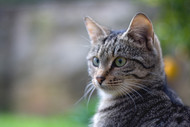What is whisker fatigue?
28th Sep 2023
“Whisker fatigue” is a curious expression. Surely the whiskers of our cats do not get tried, exhausted and need to rest?!
Perhaps not. But still, it is an interesting condition and term. As cat owners, we love our pets’ facial adornments, and watching them twitch inquisitively. But is there more to them than this?
Cats are famous for their long, elegant whiskers, but they are not just for decoration. Whiskers (or vibrissae, to give them their scientific name) play a very important role in the way that cats balance and move. Each whisker is joined to a nerve receptor called a proprioceptor deep within their skin, joining the whiskers to the cat’s nervous system. These receptors use the smallest movements to map out the cat’s surroundings. This is what makes cats so good at fitting into small spaces, moving around in the dark, and hunting their prey. Your cat’s precise movements are being guided by the signals being received by their whiskers.
Because the whiskers are so sensitive to even the smallest touches, it is no surprise that it can be unpleasant, or even uncomfortable when their whiskers are pushed into, or moved by a force greater than they were designed for. This is what we mean by whisker fatigue.
Whisker fatigue can be caused by a number of things. Broadly speaking, anything that causes a movement of the whiskers outside of their “comfort zone”. This can be if you stroke your cat’s face and bush against their whiskers, when they squeeze in a small place, or when they are using a narrow food or water bowl. This overstimulation bombards the cat’s nervous system with messages.
Whisker fatigue is also known as whisker stress, this is perhaps a slightly better description but neither offer an accurate explanation as to what a cat is feeling when this happens. If anything, it is an overstimulation, aversion, or a feeling of overwhelment. Whisker “fatigue” or “stress” are rather exaggerated terms.
What signs can you look out for if you think you cat is suffering from whisker fatigue?
- Your cat is reluctant to eat or drink, even though they seem hungry.
- They are pawing at their food and taking it out of their bowl to eat on the floor.
- They are restless and pacing around.
- They are rubbing their face on the floor or objects around the house.
Of course, the above symptoms can also be caused by a number of more serious conditions. If you are concerned, you should seek the advice of your veterinarian.
Whilst whisker fatigue is not a disease or illness in itself, it can cause health concerns in the long run if it gives your cat an aversion to eating or drinking, and so should be managed. An anxious and stressed cat will not be a happy and healthy cat.
The best way to avoid whisker fatigue in your cat is by leaving their whiskers alone and not touching them. They will also benefit from flat, wide food bowls to eat from and water fountains to drink from, avoiding all unnecessary contact with their whiskers. If you do not have a water fountain, ensure your cat’s water bowl is very full, so they can lap the water without putting their face into the bowl. Do not be tempted to trim their whiskers because they are an important anatomical instrument.
